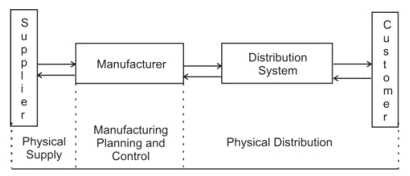APICS CSCP Exam Questions
Questions for the CSCP were updated on : Apr 19 ,2025
Page 1 out of 26. Viewing questions 1-15 out of 388
Question 1
The question below is based on the following flowchart:
Which of the following phrases most accurately describes the complete flow of demand information?
- A. From supplier to customer
- B. From customer to manufacturer
- C. From customer to supplier
- D. From supplier to manufacturer
Answer:
C
Question 2
The focus of collaborative supply chain management differs from a transactional approach by its
emphasis on the:
- A. transportation of goods to the next link in the chain.
- B. flow of product information up to the next level of the chain.
- C. flow of demand information and cash up the chain.
- D. flow of supply into an organization.
Answer:
C
Question 3
Which of the following scenarios represents a correct application of the Supply-Chain Operations
Reference-model (SCOR)?
- A. Sales and marketing refers to SCOR to improve demand generation.
- B. Production and engineering uses SCOR best practices to design a new "make" process flow.
- C. Distribution and logistics selects suppliers from the SCOR reference list.
- D. Marketing and development incorporates SCOR Level I metrics for new product design.
Answer:
B
Question 4
The primary objective of supply chain management is:
- A. minimizing transportation costs.
- B. reducing inventory levels.
- C. taking a systems approach.
- D. implementing advanced technologies.
Answer:
C
Question 5
Which of the following levels in a supply chain network represents the most upstream external
activity?
- A. Supplier to contractor
- B. Manufacturing to supplier
- C. Customer to distribution
- D. Customer to contractor
Answer:
A
Question 6
Which of the following marketing strategies emphasizes offering services at a lower price than rival
services with comparable features?
- A. Cost leadership
- B. Service differentiation
- C. Customer focus
- D. Market responsiveness
Answer:
A
Question 7
The primary reason for the evolution of the supply chain is:
- A. fewer rejects due to poor quality.
- B. increased on-time delivery.
- C. increased cost savings.
- D. increased communication.
Answer:
D
Question 8
Which of the following factors typically is the most significant impediment to implementing
collaborative commerce?
- A. Technology barriers
- B. Security
- C. Corporate culture
- D. Return on investment (ROI)
Answer:
C
Question 9
Compared to a global strategy, a multicountry strategy would be characterized by:
- A. strategy coordination across countries.
- B. preferred suppliers located in host countries.
- C. major strategic decisions coordinated centrally.
- D. products adapted to local needs.
Answer:
D
Question 10
Which of the following corporate strategies is most consistent with a flexible supply chain strategy?
- A. Being the low-price leader
- B. Providing the highest-quality service
- C. Providing mature products with stable sales
- D. Emphasizing the quality of the product
Answer:
B
Question 11
Which of the following considerations is an important supply chain design decision?
- A. Product design
- B. Selecting supporting information systems
- C. Identifying labor force requirements
- D. Identifying training programs
Answer:
B
Question 12
When designing a supply chain for strategic advantage, a company first should consider:
- A. the impact on customers using Just-in-Time manufacturing.
- B. the financial stability of suppliers.
- C. matching the supply chain to product type.
- D. whether to use custom or standard parts.
Answer:
C
Question 13
Supply chains delivering products or services are most able to respond quickly to changing market
requirements when:
- A. products have been standardized.
- B. products have a modular design.
- C. production processes have been standardized.
- D. production processes have been simplified.
Answer:
B
Question 14
Risk pooling enables a lower total inventory level without affecting service levels based on which of
the following assumptions?
- A. Inventory turnover ratio can be reduced.
- B. Aggregate demand is more accurate than disaggregate demand.
- C. The planning time fence can be adjusted as needed.
- D. The supplier shares some risk for holding inventory.
Answer:
B
Question 15
The purpose of continuous improvement in the supply chain is to:
- A. eliminate the root causes of problems.
- B. improve interorganizational communication.
- C. develop better written procedures.
- D. reduce product costs.
Answer:
A